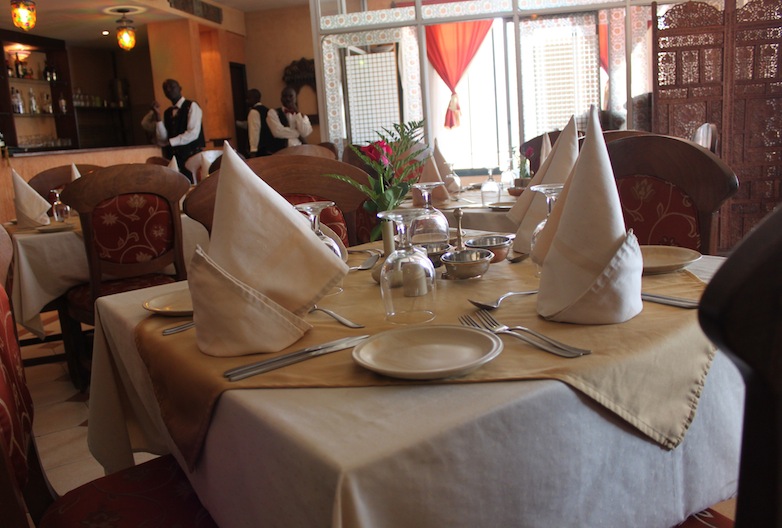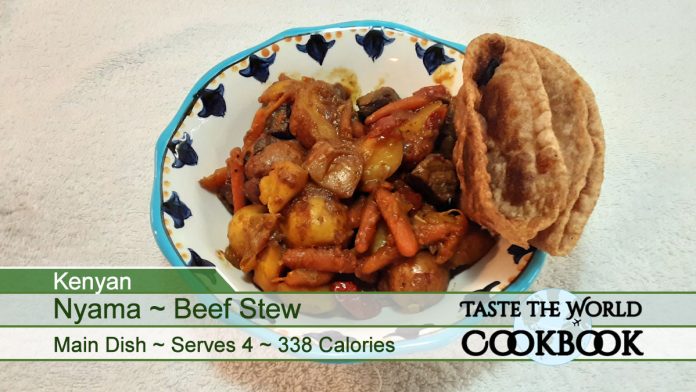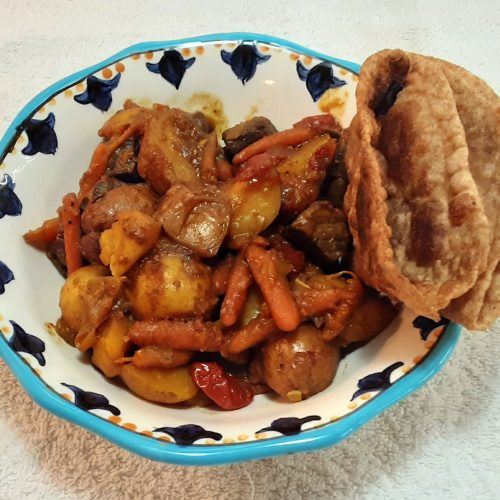Welcome to the vibrant culinary scene of Nairobi, Kenya, with this tantalizing Nyama Beef Stew. Every bite of this hearty dish bursts with flavor, intertwining tender stewing beef, robust root vegetables, and a medley of delectable spices. The result is a beef dish that delivers an enticing blend of tastes, transporting your palate straight to the heart of Kenya.
Nyama, meaning meat in Swahili, is a traditional Kenyan stew slowly simmered until the vegetables reach the perfect level of softness. The process lets the ingredients meld together, creating a flavorful stew where each component shines while contributing to a harmonious whole. This meticulous simmering ensures the stew becomes nearly liquid-free, retaining a thick, luxurious consistency.
The final touch to this delicious culinary journey is a side of Homemade Chapati, a type of flatbread. The dense, soft Chapati is the perfect companion to the hearty Nyama, allowing you to scoop up every last bit of the rich stew. So, delve into the unique flavor profile of this Kenyan Beef Stew and discover a new dimension to your dining experience.
Table of contents
Exploring Different Approaches to Making Beef Stew
Nyama, a traditional Kenyan stew, is a testament to the versatility of stew-making. While goat or chicken variations exist, the classic version uses succulent chunks of beef. This choice of meat enriches the stew with a robust flavor, making it the preferred option in many Kenyan homes. Each bite of the stew delivers a culinary experience that encapsulates the essence of Kenyan cuisine.
The magic of Nyama lies in its aromatic blend, complementing the beef’s natural richness. This stew, celebrated for its hearty, full-bodied flavor, becomes the centerpiece of any meal. Whether it’s a family gathering or a quiet dinner, the presence of Nyama promises a satisfying, comforting dining experience.
But the journey of Nyama doesn’t end with the stew itself. The beauty of this dish is in its pairing. Nyama pairs exceptionally well with a side of fluffy rice or soft chapati, enhancing the stew’s delicious complexity. These sides, with their subtle flavors, serve as the perfect canvas for the bold Nyama, making every meal an unforgettable experience.
Preserving the Flavor: Storing Your Beef Stew
Preserving the freshness and taste of your Beef Stew is simpler than you might think. For short-term storage, transfer your stew into an airtight container and place it in the refrigerator. Properly refrigerated, the stew will maintain its delectable taste and texture for 3 to 4 days, making it perfect for leftover meals or quick weekday dinners.
If you’re thinking ahead or have made a large batch, freezing is an excellent option. Just like with refrigeration, place the stew in an airtight container, ensuring that it’s sealed securely to prevent freezer burn. This method will allow you to savor your delicious Beef Stew even up to 6 months later.
Whether you’re looking forward to leftovers in the next few days or planning meals for the future, these storage tips ensure that your Beef Stew remains as delightful as the day you cooked it. Follow these simple steps, and you’ll always be ready to enjoy a hearty, home-cooked meal.
Journey of the Stew: From Ancient Times to Nairobi, Kenya
The historical trail of stews begins in the heart of ancient civilizations. The earliest evidence of stew can be traced back to Japan’s Jōmon period, exemplifying our ancestors’ culinary ingenuity in creating fulfilling, satisfying dishes. This stew legacy, ubiquitous across different cultures and eras, surmounts geographical and temporal barriers.
Following the chronological culinary footprints, we encounter an intriguing anecdote by the ancient Greek historian Herodotus. He portrayed the Scythians, nomadic warriors from the 8th to 4th centuries BC, concocting a primitive stew. They combined meat and water inside an animal’s paunch and simmered this mixture over a bone fire, echoing the spirit of stew-making in its rudimentary form.
The historical journey of stew leads us to the vibrant city of Nairobi, Kenya. Here, the ancient culinary tradition finds its expression in the form of Nyama, a rich and hearty Kenyan Beef Stew. The essence of stew— a warm, flavorful, comfort-inducing dish— remains intact across the centuries, whether simmered on an ancient hearth or in the bustling kitchens of Nairobi. The Nyama stew stands as a testament to the timeless appeal of this dish, etching its place in Kenya’s culinary heritage.
Nairobi, Kenya: The Vibrant Heart of East Africa
As Kenya’s pulsating capital, Nairobi effortlessly combines the bustling energy of a large city with the captivating allure of nature. Originating from the Maasai phrase “Enkare Nyorobi”, which translates to the “place of cool waters”, Nairobi earns its name from the river that gently winds its way through the city. This convergence of urban life and natural beauty, along with a population of 4,397,073, according to the 2019 census, makes Nairobi a vibrant metropolis teeming with life.





Nairobi’s multifaceted charm extends beyond its city limits. With a sprawling metropolitan area that’s home to over 9 million people, the city radiates its influence far and wide. The hum of city life seamlessly blends with the tranquility of its natural surroundings, making Nairobi an urban haven amidst Kenya’s expansive landscapes.
Known affectionately as the “Green City in the Sun”, Nairobi is a city that embraces its roots while continually pushing towards the future. Whether you’re delving into the city’s rich history, exploring its diverse tourism offerings, or savoring its unique culinary delights, Nairobi beckons with a promise of adventure and discovery. This dynamic city offers a unique blend of experiences that are as diverse and captivating as the people who call it home.
Nairobi: From Humble Beginnings to Bustling Metropolis
Long before the establishment of Nairobi, the area it now occupies was a pristine, untouched land frequented by early human settlers. Over the course of centuries, these settlers transformed the region from a wilderness into a thriving hub of human activity. Yet, it wasn’t until the late 19th century that Nairobi began to take shape as we know it today. At that time, this part of the land, an uninhabited swamp, became a colonial railway settlement, marking the beginning of a transformative journey.
The arrival of the railhead in 1899 brought significant change to the region. The British colonial capital of Ukamba province, previously located in Machakos (now known as Masaku), relocated to Nairobi. This strategic move propelled Nairobi into the limelight, and by 1905, the once untouched marsh had evolved into the bustling capital of the British East Africa Protectorate.
The years that followed saw Nairobi undergo a rapid expansion. Between 1902 and 1910, the town’s population mushroomed from 5,000 to 16,000, reflecting the city’s growth in administration and the burgeoning tourism sector. However, the rapid growth also ignited conflicts, most notably the Mau Mau Uprising in the 1950s. The subsequent Lancaster House Conferences marked a turning point, setting the stage for Kenyan independence in 1963. Through its trials and triumphs, Nairobi has demonstrated a remarkable resilience, transforming from an early human settlement to a vibrant metropolis that it is today.
Exploring Nairobi: A City Within A Wildlife Paradise
Beyond its bustling city life, Nairobi houses a unique treasure – the Nairobi National Park. This expansive game reserve, sitting at the city’s doorstep, is a sanctuary for the endangered black rhino. The park’s verdant landscapes provide a natural habitat for a diverse range of wildlife, including graceful giraffes, zebras, and awe-inspiring lions. This juxtaposition of urban life and natural wonders positions Nairobi as a unique destination, offering an unparalleled blend of experiences for the adventurous traveler.
Adding to Nairobi’s eco-tourism appeal is the David Sheldrick Wildlife Trust. Situated next to the Nairobi National Park, this well-regarded elephant orphanage is a testament to Nairobi’s commitment to wildlife conservation. Here, visitors can witness the inspiring efforts to nurture and rehabilitate orphaned elephants, providing a heartwarming encounter that’s bound to leave a lasting impression.
While Nairobi is a destination in its own right, its strategic location makes it a popular gateway for safari trips across Kenya. From witnessing the Great Migration in the Maasai Mara to exploring the wildlife-rich landscapes of Tsavo, Nairobi offers easy access to some of the world’s most renowned wildlife spectacles. So whether you’re keen to delve into urban exploration or embark on a wildlife adventure, Nairobi offers a springboard to a diverse range of experiences.
A Melting Pot of Flavors: Nairobi’s Diverse Cuisine
In Nairobi, the culinary scene is a vibrant tapestry woven with diverse culinary traditions. At the heart of the local Kenyan fare is ‘ugali’, a staple made from maize meal, paired with ‘sukuma wiki’, a leafy vegetable akin to collard greens. Completing this quintessential meal is often a hearty meat stew or a succulent wet fry. The gastronomic ensemble doesn’t stop there. Chapatis, beans, mung beans, maize, and kachumbari, a refreshing tomato and onion salad, are delightful additions that round off any Kenyan feast.
The flavors of Nairobi’s cuisine extend beyond its local fare, bearing testament to the city’s rich cultural history. The early Arab settlers introduced an array of aromatic spices, enriching the local dishes with bold and complex flavors. This influence is apparent in the spice-infused dishes that grace the city’s dining tables.
Adding another layer to Nairobi’s culinary mosaic are the culinary traditions of the East African Indian railway workers and the sweet delicacies from the Swahili coastline. These diverse influences have culminated in a food scene that’s rich, delicious, and distinctively Nairobi. Whether you’re indulging in a traditional Kenyan meal or exploring the city’s broader culinary offerings, Nairobi offers a gastronomic journey that’s as diverse and vibrant as its cultural heritage.
– Featured Restaurant –
Open House Restaurant Ltd
Gallant mall, Parklands Road, Opposite Total Station, Nairobi, Kenya

Open House Restaurants have a long successful history of delighting patrons of all ages and ethnic groups. From humble beginnings in small semi-open premises, our captivating food and impeccable service have enabled us to grow. Maintaining the same standards and excelling in others, we now have two wonderful venues to boast.
The Mughals were known for their style and splendor – and their food habits were no different. Rich creamy sauces, aromatic spices, and traditional recipes full of distinctive flavors in a myriad of styles. The marinated tandoori dishes are an inviting treat for small meals or a great accompaniment to the satisfying main courses. Open House caters to the mild eaters as well as the experienced chilly fans. The homemade classic desserts are an exceptionally pleasant way to end the perfect meal
Creating the Perfect Nyama – A Step-by-Step Guide to Kenyan Beef Stew
Firstly, timing is key when cooking Nyama, the aromatic Kenyan Beef Stew. It’s wise to kick start the stew-making process before you venture into making chapati, ensuring everything flows seamlessly. The simmering of the beef stew, a process which draws out the rich flavors and creates a delightful, stew-like consistency, will take approximately an hour. It’s during this period of gentle simmering that the beef stock will reduce, enhancing the overall flavor of your Nyama.
While your stew is bubbling away, turn your culinary attention to the chapati. Chapati, a type of flatbread, is a delightful accompaniment to Nyama and requires about an hour of rest time before shaping and cooking. So, this is the perfect opportunity to get started on it, while the stew is steadily reaching its peak.
By the time your stew has achieved its robust, thick consistency, your chapati dough will be perfectly rested and ready to be shaped and cooked. This careful orchestration of cooking processes ensures that both the Nyama and chapati are ready concurrently, guaranteeing a warm, fresh, and aromatic Kenyan meal straight from your kitchen to the dining table.
Preparing to Master Kenyan Beef Stew: What You’ll Need
Let’s bring your Kenyan Beef Stew to life! Before you start, ensure all your equipment and ingredients are on hand and within easy reach. Then, follow the directions outlined below. This preparatory step ensures a smooth, efficient cooking process, allowing you to fully immerse yourself in creating this delicious Kenyan dish.
Equipment
- 1 Knife
- 1 Cutting Board
- 1 Dutch Oven
- 1 Stirring Spoon
For the Stew
- 1 tbsp vegetable oil
- 1 large onion, chopped
- 1½ lbs beef, cubed
- 1-inch ginger root, minced or grated
- 4 cloves garlic, sliced
- 1 tsp hot paprika
- 1 tbsp curry powder
- 2 tomatoes
- 2 small carrots, chopped
- 1 potato, cubed
- 1½ cups beef broth, as needed
For the Chapati
- 3 cups whole wheat flour
- 1 cup water
- 1 tsp salt
- 1 tsp white sugar
- vegetable oil for frying
- whole wheat flour for rolling and dusting
Time needed: 1 hour and 20 minutes
How to Make Kenyan Stewed Beef
- Prepare Your Ingredients
Cut the onion, tomato, carrot, potato, and beef into average hunks.
- Sauté the Onions and Brown the Beef
In a large dutch oven, brown the onions in oil over medium heat. Then increase the heat to high, add the beef, and brown.
- Add the Remaining Ingredients
Add the ginger, garlic, hot paprika, curry, carrots, potatoes, tomatoes, the stock, and season with salt.
- Simmer and Reduce the Stew
Simmer uncovered until thick and pasty and all broth has reduced away. This takes about an hour.
- Serve the Stew
Remove from heat and serve with fresh chapati.
- To Make the Chapati
In a large mixing bowl add 3 cups of flour.
- Mix the Liquid Ingredients
Add salt, sugar, 2 tbsp of oil, and 1 ½ cups of water in a separate jar/ bowl. Stir until the salt and sugar dissolve.
- Add Liquid Mix
Add the liquid mixture to the flour bowl and mix well.
- Knead for 10 Minutes
Keep kneading for 10 minutes and add flour if needed until the dough becomes non-sticky. Add 2-3 tbsp of oil and continue kneading until the oil mixes well and the dough is soft. Cover the dough and leave it for 40 minutes.
- Divide the Dough
After the 40 minutes, divide the dough into 10 – 15 equal parts making ball-like shapes. Arrange them on a flat surface dusted with flour(Cover with a damp tablecloth to avoid drying).
- Dust with Flour
Dust flour in the flat place and take one of the balls and start rolling with a rolling pin to a circular shape, brush oil on top and roll it inwards to form a shape like a rope, then create a coil-like shape and press the ball down with your palm to make it flat. Repeat this process to the rest of the remaining balls of dough.
- Roll the Dough
Next, start rolling each of the coil-like shape doughs with the rolling pin to form a circular shape again.
- Fry the Chapati
In a hot pan, place the rolled-out circular chapati and fry each side with little oil until its golden brown on medium heat. Place your cooked chapati in a flat plate and cover with aluminum foil.
- Repeat until Done
Repeat this step to the rest of the dough.
Unleash your creativity with this versatile recipe! Feel free to infuse your own personal touch by adding green peppers, courgettes, or peas. Not only will it boost the nutritional value, but it’ll also enrich the flavors, making each bite even more delightful. So go ahead, experiment with your preferred ingredients and relish the delectable results. Enjoy your personalized Kenyan Beef Stew!
If you liked this dish please Rate This Recipe and leave a comment.
Nyama ~ Kenyan Beef Stew
Please Rate this Recipe
Equipment
- 1 Knife
Ingredients
For the Stew
- 1 large yellow onion chopped
- 2 tomatoes
- 2 small carrot chopped
- 1 russet potatoes cubed
- 1½ lbs beef roast cubed
- 1 tbsp vegetable oil
- 1 inch ginger root minced or 1¼ tsp of ground ginger
- 4 cloves garlic sliced
- 1 tsp hot paprika
- 1 tbsp curry powder
- 1½ cups beef broth as needed
- salt to taste
For the Chapati
- 3 cups whole wheat flour
- 1 cup water
- 1 tsp salt
- 1 tsp white sugar
- vegetable oil for frying
- whole wheat flour for rolling and dusting
Instructions
For the Stew
- Cut the onion, tomato, carrot, potato, and beef into average hunks.1 large yellow onion, 2 tomatoes, 2 small carrot, 1 russet potatoes, 1½ lbs beef roast
- In a large dutch oven, brown the onions in oil over medium heat. Then increase the heat to high, add the beef, and brown.1 tbsp vegetable oil
- Add the ginger, garlic, hot paprika, curry, carrots, potatoes, tomatoes, the stock, and season with salt.1 inch ginger root, 4 cloves garlic, 1 tsp hot paprika, 1 tbsp curry powder, 1½ cups beef broth, salt
- Simmer uncovered until thick and pasty and all broth has reduced away. This takes about an hour.
- Remove from heat and serve with fresh chapati.
For the Chipi
- In a large mixing bowl add 3 cups of flour.3 cups whole wheat flour
- Add salt, sugar, 2 tbsp of oil, and 1 ½ cups of water in a separate jar/ bowl. Stir until the salt and sugar dissolve.1 cup water, 1 tsp salt, vegetable oil, 1 tsp white sugar
- Add the liquid mixture in step 2 to the flour bowl (step 1) and mix well.
- Keep kneading for 10 minutes and add flour if needed until the dough becomes non-sticky. Add 2-3 tbsp of oil and continue kneading until the oil mixes well and the dough is soft. Cover the dough and leave it for 40 minutes.
- After the 40 minutes, divide the dough into 10 – 15 equal parts making ball-like shapes. Arrange them on a flat surface dusted with flour(Cover with a damp tablecloth to avoid drying).whole wheat flour
- Dust flour in the flat place and take one of the balls and start rolling with a rolling pin to a circular shape, brush oil on top and roll it inwards to form a shape like a rope, then create a coil-like shape and press the ball down with your palm to make it flat. Repeat this process to the rest of the remaining balls of dough.
- Next, start rolling each of the coil-like shape doughs with the rolling pin to form a circular shape again.
- In a hot pan, place the rolled-out circular chapati and fry each side with little oil until it's golden brown on medium heat. Place your cooked chapati in a flat plate and cover with aluminum foil.
- Repeat this step to the rest of the coil-like dough.
Nutrition
Complementary Culinary Explorations to Pair with Kenyan Beef Stew
Dive deeper into the flavorful world of Kenyan cuisine with these suggested accompaniments to your Nyama. Each of these dishes brings its own unique charm to the table, perfectly complementing the rich, robust flavors of our Kenyan Beef Stew. From the heart of Africa to your home, these recipes invite you to further explore the diverse culinary landscape of Kenya.
Whether you’re looking to recreate an authentic Kenyan feast, or simply searching for the perfect sides to your hearty stew, these recipes are here to inspire and delight. They not only harmonize beautifully with the Nyama, but also stand tall on their own, bringing the vibrant, rich, and comforting flavors of Kenya straight into your kitchen. Enjoy this delicious journey through Kenyan cuisine!
Photo Credits:
- By Taste The World Cookbook – Copyright 2022 All rights reserved.
- By Open House Restaurant Ltd – By https://www.openhouserestaurant.co.ke/
- By afromusing – Flickr: Nairobi Skyline, CC BY 2.0, https://commons.wikimedia.org/w/index.php?curid=29600773
- By Nairobi123 – Own work, CC BY-SA 4.0, https://commons.wikimedia.org/w/index.php?curid=34811452
- By Allan Kamaliki – Own work, CC BY-SA 4.0, https://commons.wikimedia.org/w/index.php?curid=49475045
- By Bobokine – Own work, CC BY-SA 3.0, https://commons.wikimedia.org/w/index.php?curid=8335981
- By Africanmodern – Own work, CC BY-SA 4.0, https://commons.wikimedia.org/w/index.php?curid=48523304


